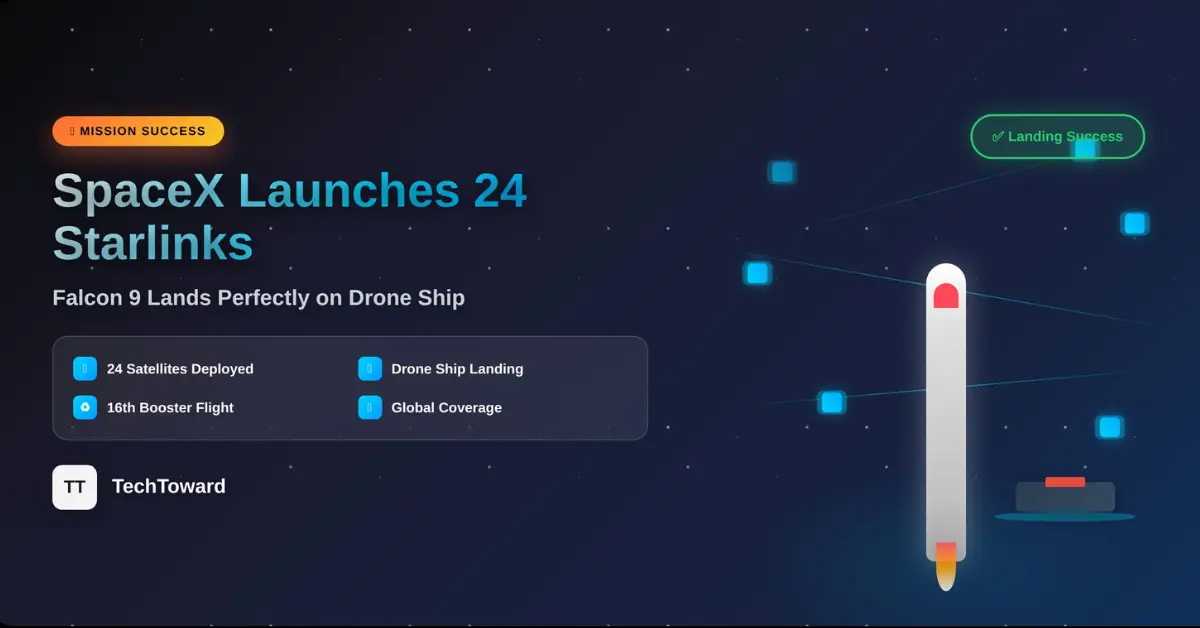SpaceX continues to reshape global communications with its Starlink satellite launches. On September 26, 2025, the company launched 24 Starlink satellites from Vandenberg Space Force Base in California. The Falcon 9 rocket’s first stage landed flawlessly on a drone ship at sea—an achievement that highlights the revolutionary engineering powering Elon Musk’s vision of universal internet access.
This mission was not just another launch. It represents how reusable rockets and mass-produced satellites are redefining connectivity, making high-speed internet available across the globe.
What Makes Starlink Revolutionary?
The Starlink program is the world’s largest satellite internet constellation, designed to provide broadband connectivity even in the most remote regions. Unlike traditional internet systems dependent on cables and towers, Starlink satellites act as floating internet towers in space, beaming data directly to ground antennas.
Each satellite weighs about 573 pounds (260 kg) and unfolds to the size of a dining table. Positioned in Low Earth Orbit (LEO) around 340 miles above Earth, these satellites deliver faster speeds and lower latency than traditional geostationary satellites.
How SpaceX Launches 24 Satellites at Once
The Falcon 9 Rocket
SpaceX uses its Falcon 9, a 230-foot-tall two-stage rocket powered by nine Merlin engines producing 1.7 million pounds of thrust. The standout feature is reusability—the same booster can be flown over a dozen times. The latest mission used booster B1082, on its 16th flight, showcasing cost-efficiency and durability.
Launch Sequence
- Pre-Launch: Satellite integration, fueling with kerosene and liquid oxygen, weather checks, safety clearance.
- Liftoff & Ascent (T+0 to T+2:30): Engines ignite, rocket pushes through atmosphere, reaching Max-Q at ~T+1:12.
- Stage Separation: First stage separates, begins return; second stage carries satellites to orbit.
- Satellite Deployment (T+15 to T+60 min): Satellites release in batches, activate ion thrusters, and establish communication.
The Precision of Drone Ship Landings
A highlight of Falcon 9 missions is the autonomous landing of the first stage on drone ships with whimsical names like Of Course I Still Love You. These 300-by-170-foot platforms enable recoveries too far downrange for a land return.
The landing involves three controlled burns:
- Boostback Burn to reverse course.
- Entry Burn to slow re-entry.
- Landing Burn for a soft, vertical touchdown.
All of this happens automatically, with real-time corrections for wind, waves, and ship movement.
Why Ship Landings Matter
Landing at sea preserves fuel and maximizes payload capacity. For missions targeting specific orbits, returning to the launch site simply isn’t feasible. Drone ships extend the rocket’s reach while enabling reusability.
The Growing Starlink Constellation
By September 2025, over 5,000 Starlink satellites were operational. SpaceX has conducted 27 Starlink launches from Vandenberg this year alone, with a total of 39 Falcon 9 missions from that site. Overall, the company targets 170 launches in 2025, a record-setting pace.
The initial constellation calls for 12,000 satellites, with potential expansion to 42,000. This creates near-total global coverage, with redundancy built into the system.
Real-World Applications
Starlink’s impact is wide-ranging:
- Disaster Response: Emergency teams maintain connectivity even when ground networks fail.
- Maritime Connectivity: Cargo ships, yachts, and cruise liners now access broadband internet.
- Military Uses: Secure communications in remote or conflict areas.
- Education: Rural schools gain online access to resources previously out of reach.
Inside the Technology
Satellite Features (V2 Mini)
- Phased Array Antennas: Software-controlled beam steering.
- Ion Thrusters: Efficient propulsion for positioning and deorbiting.
- Solar Panels: Generate ~20 kW per satellite.
- Laser Links: Allow satellites to talk to one another, reducing reliance on ground stations.
Constellation Architecture
Satellites are arranged in orbital “shells” for global coverage:
- 550 km, 53° inclination – 1,584 sats
- 540 km, 53.2° – 1,584 sats
- 570 km, 70° – 720 sats
- 560 km, 97.6° – 348 sats
This network ensures multiple satellites are always in view, minimizing service interruptions.
The Economics of Starlink
Lower Launch Costs
Traditional launches cost $10,000–$20,000 per kg. Thanks to reusable Falcon 9s, SpaceX slashes this to about $2,700/kg. Some boosters have flown over 20 times, making launches economical enough to sustain Starlink’s scale.
With 400+ successful drone ship landings, reusability is no longer experimental—it’s proven.
Revenue Streams
- Residential Plans: $120/month + $599 hardware
- Mobile/Roaming Plans: $150+/month
- Business Contracts: $500+/month, premium features
- Government & Military Deals: High-value, secure communication services
- Maritime & Aviation Services: For ships, planes, and RVs
The satellite internet market exceeds $400 billion, and Starlink is positioned to capture a significant share.
Environmental Considerations
Positives
- Less need for ground infrastructure in remote areas.
- Lower per-user carbon footprint than fiber in sparsely populated regions.
- Maintains resilience during natural disasters.
Concerns & Solutions
- Space Debris: Satellites deorbit automatically within 5–7 years.
- Collision Avoidance: Autonomous maneuvering plus ground monitoring.
- Brightness: New coatings reduce visibility for astronomers.
The Future of Starlink
Next-Generation Satellites (V3)
- Larger and up to 10x more powerful
- Direct-to-cell connectivity (works with ordinary smartphones)
- Faster laser interlinks
- Expanded polar coverage
Starship Integration
SpaceX’s Starship will accelerate deployment, carrying up to 400 satellites per flight, compared to Falcon 9’s 24–60. This will enable rapid growth and replacement of aging satellites.
Long-Term Vision
- Universal Access: High-speed internet everywhere.
- Mars Communications: Supporting future colonization.
- Aviation & Maritime Expansion: Global coverage for travel.
- IoT & Smart Cities: Connecting billions of devices worldwide.
How to Access Starlink
Service Plans
- Residential: $120/month + $599 equipment; 25–220 Mbps download
- Roam: $150/month; for RVs, boats, and mobile users.
- Business: $500+/month; higher priority and support.
Setup Process
- Order the kit online.
- Use the Starlink app to find a clear sky view.
- Mount the dish, connect power and router.
- Activate service.
Installation usually takes less than an hour, with no technician required.
Comparing Starlink to Traditional Internet
| Service Type | Download Speeds | Upload | Latency |
| Starlink | 25–220+ Mbps | 5–25 | 20–40 ms |
| Fiber | 100–1000+ Mbps | 100+ | 5–10 ms |
| Cable | 25–500 Mbps | 5–50 | 15–30 ms |
| DSL | 1–100 Mbps | 1–10 | 20–50 ms |
| Traditional Sat | 12–100 Mbps | 3–5 | 600–800 ms |
Advantages of Starlink
- Works globally with clear sky view
- No reliance on local infrastructure
- Resilient during disasters
- Portable for vehicles and ships
Limitations
- Weather can affect signal
- Requires clear line of sight
- Power-dependent
- Possible slower speeds during peak usage
Global Impact
Starlink helps close the digital divide, connecting the 3.7 billion people still offline.
- Education: Online resources for rural students.
- Healthcare: Telemedicine access.
- Business: Remote workers and e-commerce opportunities.
- Agriculture: Smart farming enabled by reliable connectivity.
- Emergency Services: More effective disaster response.
Challenges and Solutions
- Space Traffic: Managed through autonomous satellite maneuvers, tracking, and coordination with other operators.
- Network Optimization: AI-driven load balancing, predictive maintenance, and over-the-air updates keep the system efficient.
FAQs
- How fast is Starlink?
A: 25–220+ Mbps, 20–40 ms latency.
- How much does it cost?
A:$120/month for residential; higher for roaming and business.
- Where does it work?
A: Anywhere with a clear sky, expanding globally.
- Why land on ships?
A: Saves fuel, enables recovery after far-reaching launches.
- What happens to old satellites?
A: They deorbit within 5–7 years.
- Does weather affect service?
A: Heavy rain/snow can cause slowdowns but usually maintains connectivity.
- Is it better than fiber?
A: Fiber is faster and lower latency but limited in availability. Starlink works nearly everywhere.
Conclusion: The Dawn of Universal Internet
The September 2025 launch of 24 Starlink satellites—SpaceX’s **100th Falcon 9 mission this year—**marks another milestone in global connectivity. With precision landings, reusable rockets, and mass satellite deployment, Elon Musk’s vision of a connected planet is becoming reality.
For rural regions, disaster zones, and developing nations, Starlink brings opportunities once limited to urban centers: education, healthcare, and global commerce. With next-gen satellites, direct-to-cell service, and Starship launches on the horizon, the global internet revolution has only just begun.
🌍 The stars are becoming the backbone of a truly universal network.


